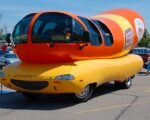Vehicle theft is a serious problem in Ontario, especially in the Greater Toronto Area (GTA). Thieves are using sophisticated methods to target and steal vehicles, such as placing hidden tracking devices on them. However, some insurance companies and police forces are fighting back with their own tracking technology, which has helped recover hundreds of stolen vehicles and dismantle crime organizations.
Tracking devices used by thieves
According to the Ontario Provincial Police (OPP), thieves can place a tracking device on a vehicle, follow it and wait for a chance to steal it. They can study the owner’s habits and patterns, and determine the best time to strike. The tracking device can be as small as an Apple AirTag, which can connect to an iPhone and alert the owner of its presence.
The OPP said that two people near Cornwall recently made the same unsettling discovery within a 24-hour period: a tracking device had been placed on their vehicles without their knowledge. Both received notifications that an Apple AirTag tracker was trying to connect to their iPhones, but neither person owned an AirTag. They found the trackers hidden under the hood of their vehicles, which were parked in public places.
The OPP said that luxury cars are most often targeted in cases like this, with Dodge, Chrysler and Jeep products topping the lists. High-end Toyota vehicles, such as the Toyota Highlander and the Toyota Rav 4, are also sought after by thieves.
Tracking technology used by insurers and police
To combat the ongoing problem of auto theft, some insurance companies are now pushing owners of highly targeted vehicles to install tracking systems, such as the TAG vehicle tracking system. The TAG system uses a multi-level approach comprised of elements of prevention, electronic identification and proven vehicle tracking technology to help recover stolen vehicles and prevent theft.

The TAG system works by using multiple wireless transmitters affixed to different parts of a vehicle. Each transmitter has a unique serial number, making stolen parts easily identifiable and harder to sell. The system also has a 24/7 in-house recovery team that is always on standby to track and recover stolen vehicles.
Some insurance companies, such as Belairdirect and Desjardins, have sent letters to certain customers in Ontario and Quebec, asking them to install the TAG system or pay a surcharge. Some insurers have offered to cover the cost of the installation, while others have charged the customers for it.
The TAG system has been successful in helping police recover stolen vehicles and arrest suspects. For example, Steve Gimza, a Toronto resident, had his Honda CR-V stolen in November, but it was recovered with the help of the TAG system. The police also arrested two people in connection with the theft.
Police operation recovers 214 stolen vehicles
The OPP has also been using its own tracking technology to crack down on vehicle theft and organized crime. In July 2022, the OPP announced the results of Project Myra, a 10-month investigation that recovered 214 stolen vehicles worth over $11 million and dismantled three crime organizations.
The OPP said that the stolen vehicles were destined for overseas markets, such as Africa and the Middle East, where they would be sold for a high profit. The vehicles were also used to commit other crimes, such as drug trafficking and fraud.
The OPP collaborated with several forces and organizations to conduct Project Myra, including the OPP Biker Enforcement Unit, the OPP Organized Crime Towing Industry Project, Durham Regional Police Service, Halton Regional Police Service, Peel Regional Police, Saskatoon Police Service and York Regional Police, among others.
The OPP said that Project Myra was one of the largest vehicle theft investigations in Ontario’s history, and that it sent a clear message to the criminals that they would not get away with their illegal activities.














